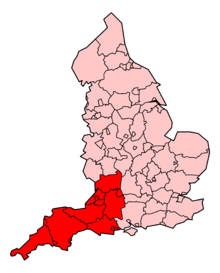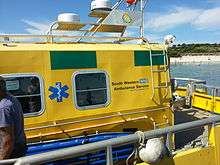South Western Ambulance Service
| South Western Ambulance Service NHS Foundation Trust | |
 | |
| Area: | South West England |
|---|---|
| Population: | 5.3 million residents |
| Size: | 51,871 km |
| Staff: | 4,000+ |
| Chief Executive (Chief Ambulance Officer): | Ken Wenman |
| Stations: | 96 + 6 Air Bases |
| HQ: | Exeter |
| Website: | www |
The South Western Ambulance Service NHS Foundation Trust (SWASFT) is the organisation responsible for providing ambulance services for the National Health Service (NHS) across South West England (the counties and unitary authorities of Bristol, Bath and North East Somerset, Cornwall, Devon, Dorset, Gloucestershire, North Somerset, the Isles of Scilly, Somerset, South Gloucestershire and Wiltshire).[1] The Foundation Trust was authorised on 1 March 2011 by Monitor (the Independent Regulator for NHS Foundation Trusts) to run the ambulance services run previously by the NHS Trust as a result of the merger of the Westcountry and Dorset ambulance services, and the subsequent merger with neighbouring Great Western Ambulance Service on 1 February 2013. This latter merger was announced in 2011,[2][3] and staff were asked to accept changes in their pay and conditions.[4]

It is one of ten Ambulance Trusts providing England with emergency medical services, receiving government funding for its role. There is no charge to patients for use of the service, although costs will be recovered and paid to the ambulance trust in cases of personal injury through the NHS Injury Cost Recovery scheme.[5]
Divisions & Stations
The trust is split into three divisions: West Division covering Devon and Cornwall including West Divisional HQ, 999 and Patient Transport Service (PTS) Control at Exeter, East Division covering Somerset and Dorset including East Divisional HQ, 999 and PTS Control at Ringwood.[6] and North Division consisting of the foot print of the former Great Western Ambulance Service NHS Trust.
The Trust has 96 ambulance stations among the counties that it serves:
- Cornwall
- Devon
- Dorset
- Somerset
- Avon
- Avonmouth
- Bristol
- Keynsham
- Soundwell
- Yate
- North Bristol Operations Centre
- Almondsbury
- Falfield
- Nailsea
- Weston-super-Mare
- Churchill
- Wiltshire
- Gloucestershire
Lydney
TewksburyFacts and figures
The Trust is one of the largest of the new trusts formed in England in 2006. Within this, it covers an area of 51,871 km and 827 miles (1,331 km) of coastline.[7] In a year, over 690,000 emergency and urgent calls are received and dealt with.
The Trust provides ambulance services for the area formerly covered by Strategic Health Authority NHS South West.
Vehicle Fleet

- 999 Emergency Ambulances – Mercedes Sprinter.
- Patient Transport Ambulances – Renault Master, Ford Tourneo, Fiat Multipla
- Rapid Response Vehicles – Skoda Octavia Scout, Ford Mondeo, Volvo XC70, Volvo V70, Volvo V50, Honda CRV, BMW 3 series, BMW 5 series, Renault Megane, Renault Scenic.
- Rapid Response Motorcycles – BMW R1200
- Hazardous Area Response Team – IVECO Daily, Land Rover Discovery 4, Polaris Ranger, Honda Foreman, Volvo XC70, Land Rover Defender
- Duty Officer Cars – Land Rover Discovery 4 or personal vehicles.
- Pool cars – Ford Focus Estate, Vauxhall Corsa, Vauxhall Astra and Volkswagen Polo.
- Air ambulances – Eurocopter EC135 (Cornwall Air Ambulance, Devon Air Ambulance (two), and Dorset and Somerset Air Ambulance), McDonnell Douglas 902 Explorer (Wiltshire Air Ambulance), Bolkow BO-105 (Great Western Air Ambulance)
- Boat – ALN 043 'Star of Life’ Wave Saver 1000 Class Ambulance Boat
Fire service co-responders
Avon Fire and Rescue Service, Cornwall Fire and Rescue Service, Devon and Somerset Fire and Rescue Service, Dorset Fire and Rescue Service and Gloucestershire Fire and Rescue Service all work in partnership with South Western Ambulance service to provide emergency medical cover to particular areas of the Trust. These areas, often rural, have been identified as having a greater need for ambulance cover. Many of these areas do not have a local ambulance station. The aim of a co-responder teams is to preserve life until the arrival of either a Rapid Response Vehicle (RRV) or an ambulance. Co-responder vehicles are equipped with oxygen and automated external defibrillator (AED) equipment supplied by South Western Ambulance Service.[8]
Avon Fire and Rescue Service
There are currently two stations that co-respond; Thornbury and Portishead. There is also the possibility of expanding to further stations.
Cornwall Fire And Rescue Service stations
The four stations that run as co-responders are Helston, Mullion, St. Keverne, and St. Mawes.
Devon and Somerset Fire and Rescue Service stations
Co-responder stations have got a dedicated vehicle for co-responder calls. The new vehicle known as the Emergency Response Unit (ERU), replaces the fire appliance from going, providing there are enough crew still on duty to allow the fire appliance to remain available.
The 19 stations that run as co-responders are: Axminster, Chagford, Cheddar, Combe Martin, Crediton, Dawlish, Dulverton, Hartland, Hatherleigh, Holsworthy, Ivybridge, Lynton, Moretonhampstead, Nether Stowey, Porlock, Princetown, Seaton, Williton, Woolacombe
Dorset Fire and Rescue Service stations
The two stations that run as co-responders are Lyme Regis and Beaminster.[9]
Gloucestershire Fire and Rescue Service stations
Co-responding currently operates from the following stations
Lydney, Coleford, Tetbury, Wotton Under Edge, Chipping Campden and Newent.
Tiverton Minor Injuries Unit
In May 2014 the Trust won a two-year contract to run a doctor-led minor injuries unit at Tiverton District Hospital after North, East and West Devon Clinical Commissioning Group organised a poll in which more than 1,500 residents voted in favour of a 14-hour-a-day doctor-led unit instead of a 24-hour nurse-run service.[10]
See also
References
- ↑ "What we do". South Western Ambulance Service. Retrieved 6 July 2014.
- ↑ Glaister, Dan (16 November 2011). "Why South Western ambulance may rescue Great Western". The Guardian. Retrieved 16 November 2011.
- ↑ "Ambulance trusts to merge in South West". BBC. Retrieved 16 November 2011.
- ↑ "Fears over South Western Ambulance Service planned cut". BBC. Retrieved 24 November 2011.
- ↑ "NHS Injury Cost Recovery scheme". Department of Health. Retrieved 10 November 2010.
- ↑ "Contact Us". South Western Ambulance Service. Retrieved 24 November 2011.
- ↑ "Inspection Report" (PDF). Care Quality Commission. Retrieved 24 November 2011.
- ↑ "Responder Schemes". South Western Ambulance Service. Retrieved 24 November 2011.
- ↑ "Fire Service launches Co-responder Scheme in Beaminster" (pdf). Dorset Fire and Rescue Services. 4 March 2009. Retrieved 18 March 2009.
- ↑ "Ambulance service wins minor injuries unit contract". Health Service Journal. 1 May 2014. Retrieved 28 May 2014.